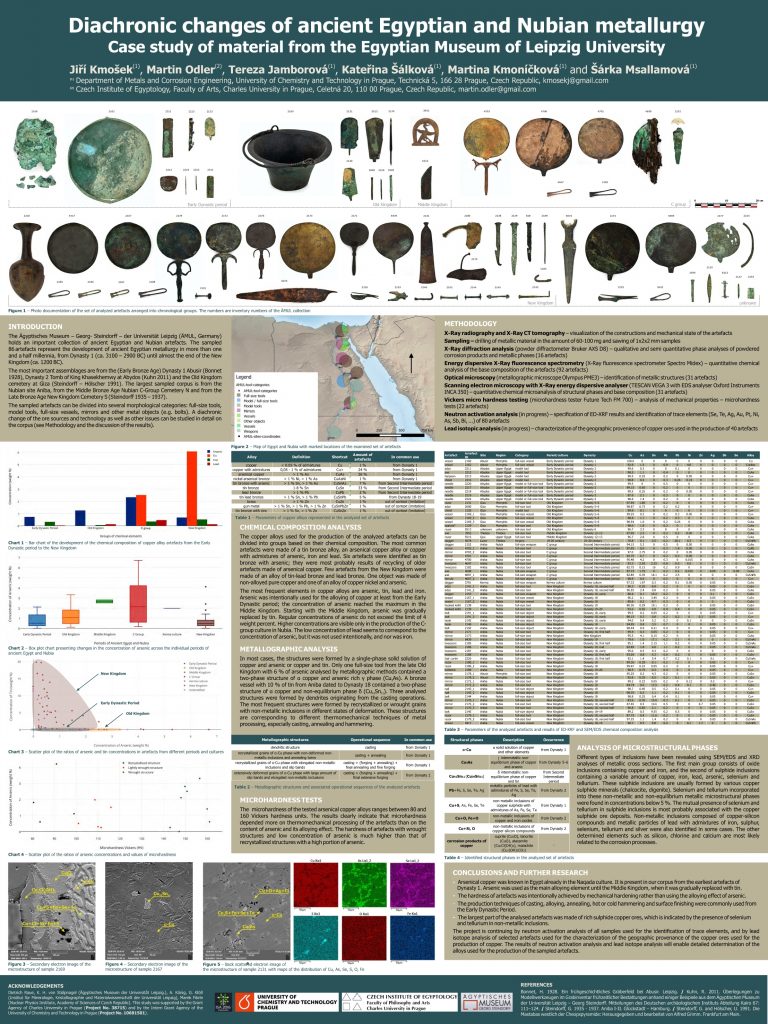The poster “Diachronic Changes of Ancient Egyptian and Nubian Metallurgy: Case study of material from the Egyptian Museum of Leipzig University“, whose main authors are Jiří Kmošek (University of Chemistry and Technology in Prague) and Martin Odler (Czech Institute of Egyptology, Faculty of Arts, Charles University in Prague), received honorable mention in the Best Student Poster Award competition at the 41st International Symposium on Archaeometry. The symposium took place from 15 – 21 May 2016 in Kalamata (Greece). The poster presents the first phase of the analysis of ancient Egyptian copper and bronze artefacts from the collection of the Egyptian Museum of Leipzig University. The award has been bestowed by the Society for Archaeological Sciences (USA) since 1998 and the authors of the posters are the first students from the Czech Republic to be included on the list. This honorable mention is even more important because the archaeometallurgy of copper and metal artefacts in general has never been studied systematically at the archaeological departments of the Faculty of Arts, Charles University in Prague.
The project Early Copper Metallurgy in Ancient Egypt – a case study of the material from Ägyptisches Museum der Universität Leipzig is focused on the analysis of a selected corpus of artefacts from the Ancient Egyptian and Nubian sites, deposited in the collection of Ägyptisches Museum der Universität Leipzig. The project is based on interdisciplinary cooperation of the humanities and natural sciences. There are three main institutions involved in the project: Czech Institute of Egyptology, CUFA, represented by its PhD candidate Martin Odler, an archaeologist specializing on copper and bronze artefacts; Institute of Chemistry and Technology in Prague represented by Bc. Jiří Kmošek, a specialist in material science and archaeometallrugy; and Ägyptisches Museum der Universität Leipzig represented by the curator of the collection, Dr Dietrich Raue. The project is financed by the Grant Agency of Charles University, project no. 38715, and last year was also financed by Internal Grant Agency of ICT, project no. 10681501.
The analysed material was found mostly at the Egyptian sites Abusir, Abydos and Giza and at the Nubian site Aniba. The artefacts represent an outline of the development of Ancient Egyptian metallurgy in more than one and half millennium, from the Dynasty 1 (ca. 3100 – 2900 BC) almost until the end of the New Kingdom (ca. 1200 BC). A detailed report on the first results of the project will be published in the journal Prague Egyptological Studies (in Czech, with an English summary).

The poster Diachronic changes of ancient Egyptian and Nubian metallurgy – Case study of material from the Egyptian Museum of Leipzig University
Abstract of the poster:
This poster presents archaeometric and archaeological study of a set of copper and bronze artefacts found at the sites of ancient Egypt and Nubia, which are deposited in the collection of Ägyptisches Museum – Georg Steindorff – der Universität Leipzig. Examined artefacts have been found at several important sites: Abydos, Abusir, Giza and Aniba. They represent the development of Ancient Egyptian metallurgy in more than one and half millennium, from the Dynasty 1 (ca. 3100 – 2900 BC) until almost the end of the New Kingdom (ca. 1200 BC). Analyzed set of 86 artefacts and almost 100 samples is covering different typological groups of the artefacts, such as full-size tools, their models, full-size vessels and mirrors, etc.
Detailed technical analysis has been carried out with the aim to obtain or specify information about chemical or structural artefact composition, using wide range of analytical techniques. All artefacts have been documented by X-ray radiography and more complex artefacts by X-ray tomography. Selected artefacts have been studied by metallographic methods in combination with micro hardness tests and SEM/EBSD analysis for better understanding of the mechanical and heat treatment production techniques. Chemical composition analyses were carried out by methods of XRF, SEM/EDS and NAA with the aim to characterize metals alloys and present admixtures. On the set of analyzed artefacts is clearly visible evolution of the alloys use across the studied periods and geographical areas. All obtained analytical data have been statistically evaluated in the context of spatial distribution, dating and function of the studied artefacts, in order to contribute to more detailed and accurate knowledge of metal production techniques and materials used in the Ancient Egyptian metallurgy.
introduction photo: Part of the conference programme took place in the ancient theatre at Messen (photo Jiří Kmošek)




